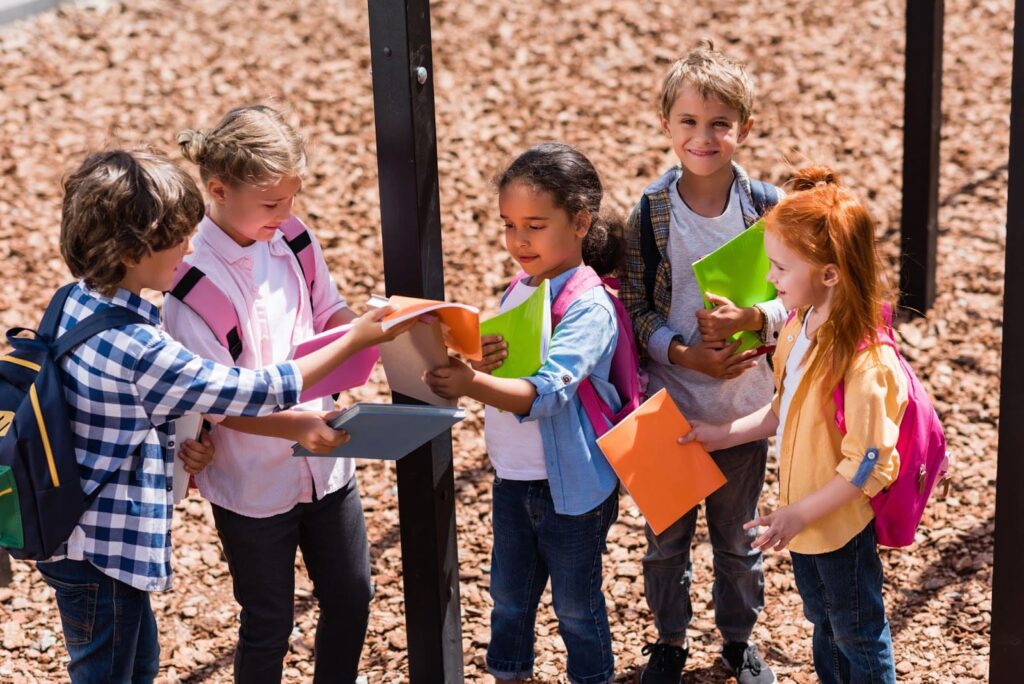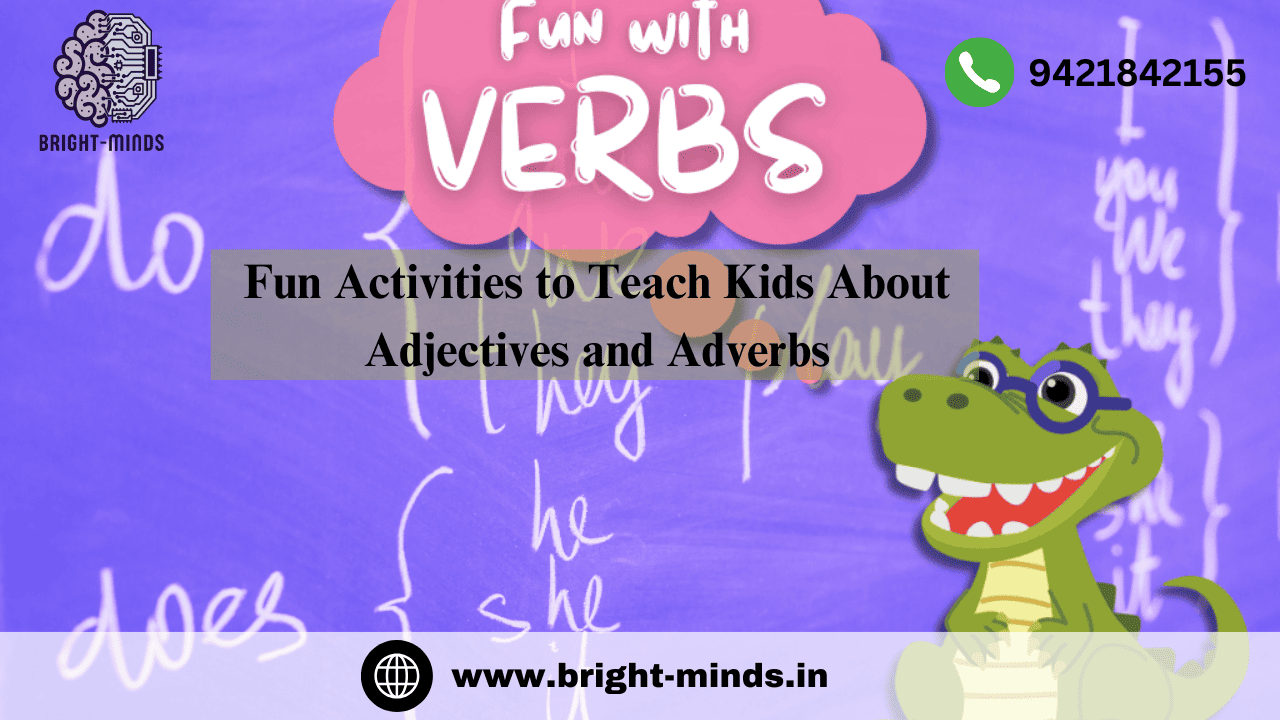Introduction
Improving children’s language and communication skills requires an understanding of adjectives and adverbs. These speech components provide phrases depth, color, and detail, which helps children communicate more clearly. By using entertaining activities that blend play and education, teaching them may be enjoyable and participatory.
Why Teach Adjectives and Adverbs?
- Expand Vocabulary:Giving children descriptive and modifying words helps them learn new words that will help them express themselves more clearly.
- Enhance Writing Skills: They get better at crafting phrases that are more interesting and vivid.
- Improve Communication: Confidence in speaking and narrating is increased when one uses clear language and appropriate modifiers.
General Tips for Teaching Adjectives and Adverbs
- Start Simple: Give simple examples such as “big,” “small,” “fast,” and “slow.”
- Visual Cues: Associate words with aspects of everyday life by using images and objects.
- Interactive Sessions: To keep participants interested, including stories and games.
Fun Activities to Teach Adjectives

1. Descriptive Object Hunt
- How to Play: To play, collect a range of items and put them in a box.
- Activity: Kids are to choose an object and use adjectives to describe it (e.g., “This is a round, red ball”).
- Learning Outcome: Builds observational skills and vocabulary.
2. Adjective Collage
- How to Play: Set out glue, scissors, and magazines.
- Activity: Let kids cut out pictures and write adjectives that describe them (e.g., “fluffy dog”).
- Learning Outcome: Enhances creativity and association.
3. Adjective Guessing Game
- How to Play: Children guess what an object is after one uses adjectives to describe it without naming it.
- Example: “It’s soft, warm, and cuddly.” (Answer: Blanket).
- Learning Outcome: Improves descriptive skills and listening.
4. Character Descriptions
- How to Play: Show kids images of fictional characters or animals
- Activity: Have them describe the characters using adjectives (e.g., “The lion is brave and strong”).
- Learning Outcome: Encourages imaginative thinking
5. Adjective Scavenger Hunt
- How to Play: Create a list of adjectives (e.g., “blue,” “shiny,” “smooth”)
- Activity: Kids find items matching those descriptions around the house or classroom
- Learning Outcome: Makes learning dynamic and hands-on.
Fun Activities to Teach Adverbs
1. Action Charades
- How to Play: Write action verbs (e.g., “run,” “jump”) and adverbs (e.g., “quickly,” “slowly”) on separate cards.
- Activity: Kids draw a card from each pile and act out the combination (e.g., “jump quickly”).
- Learning Outcome: Teaches how adverbs modify verbs.
2. Adverb Walk
- How to Play: Announce an action with an adverb (e.g., “Walk slowly,” “Run happily”).
- Activity: Kids perform the action accordingly.
- Learning Outcome: Strengthens understanding of actions and modifiers.
3. Adverb Bingo
- How to Play: Create Bingo cards with adverbs.
- Activity: Call out sentences using adverbs, and kids mark the corresponding word.
- Learning Outcome: Improves adverb recognition.
4. “How Did You Do It?” Game
- How to Play: Kids perform simple tasks (e.g., clap hands, wave) and others guess the adverb describing how it was done (e.g., “clapped loudly”).
- Learning Outcome: Encourages observational and critical thinking skills.
5. Storytime with Adverbs
- How to Play: Read a story with exaggerated adverbs and have kids identify them.
- Activity: Encourage them to rewrite parts of the story using different adverbs.
- Learning Outcome : Enhances comprehension and creativity.
Combined Activities for Adjectives and Adverbs
1. Word Sorting
- How to Play: The rules are as follows: Make a chart with two columns called “Adjectives” and “Adverbs.”
- Activity: Give children words to group into the appropriate categories.
- Learning Outcome: Develops grammar and classification abilities.
2. Sentence Building
- How to Play: Give children a list of words that includes verbs, adjectives, adverbs, and nouns.
- Activity: Ask them to use one word from each category to construct coherent sentences..
- Learning Outcome: Strengthens sentence construction.
3. Descriptive Storytelling
- How to Play: Start a story with a simple sentence.
- Activity: Kids take turns adding sentences that include adjectives and adverbs to expand the story.
- Learning Outcome: Boosts creativity and understanding of descriptive language.
4. Puppet Play
- How to Play: Use puppets to act out scenes described by kids.
- Activity: Encourage the use of adjectives and adverbs to guide the puppet’s actions.
- Learning Outcome: Combines fun and grammar in a creative way.
5. Adjective and Adverb Art
- How to Play: Provide art supplies and ask kids to draw a scene based on descriptions they create.
- Activity: For example, “Draw a happy, colorful garden where butterflies fly gracefully.”
- Learning Outcome: Merges language and art to reinforce learning.
Incorporating Adjectives and Adverbs into Daily Life
Mealtime Descriptions :
- Encourage kids to describe their food using adjectives (e.g., “crispy apple”).
- Use adverbs to discuss how they eat (e.g., “quickly”).
- Outdoor Adventures Describe the surroundings (e.g., “tall tree,” “blue sky”). Discuss actions during play (e.g., “running joyfully”).
- Role-Playing Games Act out scenarios (e.g., shopping) and include descriptive language.
Benefits of Teaching Adjectives and Adverbs Through Play
- Engagement: Play-based activities capture attention better than traditional methods.
- Retention: Interactive learning improves memory.
- Application: Kids learn to use descriptive language naturally in speech and writing.
Overcoming Challenges
- Difficulty in Differentiation
- Use examples to clarify the difference between adjectives (describing nouns) and adverbs (modifying verbs).
- Limited Vocabulary
- Gradually introduce new words to expand their range of descriptors.
- Short Attention Span
- Keep activities short and dynamic to maintain interest.
Conclusion
- Teaching adjectives and adverbs to kids can be an enjoyable experience with the right approach. By incorporating fun, interactive activities into their routine, you help them grasp these grammar concepts effortlessly. These foundational skills not only improve their communication but also instill a love for language learning. Start with these activities and watch your little learners grow into articulate storytellers!
Also Read:
https://bright-minds.in/unlocking-word-meaning-for-class-ukg-english-to-hindi/

